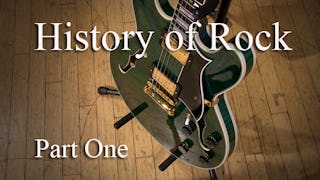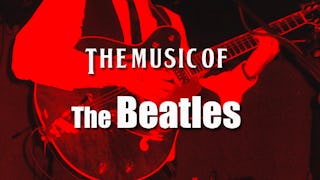This course, part 2 of a 2-course sequence, examines the history of rock, primarily as it unfolded in the United States, from the early 1970s to the early 1990s. This course covers the music of Led Zeppelin, the Allman Brothers, Carole King, Bob Marley, the Sex Pistols, Donna Summer, Michael Jackson, Madonna, Prince, Metallica, Run-DMC, and Nirvana, and many more artists, with an emphasis both on cultural context and on the music itself. We will also explore how developments in the music business and in technology helped shape the ways in which styles developed.

6 days left: Get a Black Friday boost with $160 off 10,000+ programs. Save now.


(471 reviews)
What you'll learn
Students will be able to summarize and describe how rock music progressed from the early 1970's through the early 1990's.
Details to know

Add to your LinkedIn profile
3 assignments
See how employees at top companies are mastering in-demand skills

There are 7 modules in this course
What's included
1 video6 readings
A series of styles continue to develop the combinations of late-1960s psychedelia: blues-rock, southern rock, progressive rock, jazz-rock, theatrical rock, country rock, and singer-songwriters. Rock becomes increasingly ambitious. [Read Chapter 8 and work through listening guides for that chapter, viewing dedicated video.]
What's included
9 videos
Moving along a parallel but mostly separate path, black pop develops with the help of James Brown and Sly and the Family Stone. Motown continues, the rise of funk and Blaxploitation films. Bob Marley and reggae. The emergence of disco the reaction of rock fans. [Read Chapter 9 and work through listening guides for that chapter, viewing dedicated video.]
What's included
8 videos1 assignment
Rock style from the early 70s are streamlined and labeled corporate rock, as the music business expands even further. The mega-album. Punk reacts with a return to simplicity. New wave develops the punk attitude. [Read Chapter 10 and work through listening guides and dedicated video.]
What's included
9 videos
MTV emerges from a developing cable television industry. Michael Jackson and Thriller. The rise of Madonna, Prince, and Janet Jackson. Does MTV make music more visual than aural? Mainstream rockers continue thrive. [Read Chapter 11 and work through listening guides and dedicated video.]
What's included
8 videos1 assignment
Developing out of underground scenes of the late 1970s, heavy metal and hip hop become important mainstream styles in the late 1980s, aided by exposure on MTV. The rock reaction against rap. [Read Chapter 12 and work through listening guides and dedicated video.]
What's included
9 videos
The growth of "classic rock" and the development of the history-of-rock awareness. A survey of artists as they relate to earlier trends in the history of rock, including teen idols, hip-hop, 60s-influenced rock, female singer-songwriters, dance music, indie rock, and heavy metal. [Read Chapters 13 and 14 and work through listening guides and dedicated video.]
What's included
10 videos1 assignment
Instructor

Offered by
Explore more from Music and Art
 Status: Preview
Status: PreviewUniversity of Rochester
 Status: Preview
Status: PreviewUniversity of Florida
 Status: Preview
Status: PreviewUniversity of Rochester
 Status: Preview
Status: PreviewUniversity of Rochester
Why people choose Coursera for their career




Learner reviews
471 reviews
- 5 stars
84.07%
- 4 stars
13.58%
- 3 stars
1.69%
- 2 stars
0.21%
- 1 star
0.42%
Showing 3 of 471
Reviewed on Feb 12, 2021
Continuing from Part One, the History of Rock course segues into the music scene of 70s and beyond. A thoroughly enjoyable course for anyone interested in any form of music in general.
Reviewed on Jul 12, 2020
what a fun course! brought me back to the birth of metal and hair bands . thank you so much for doing this course!!
Reviewed on Oct 6, 2015
Very interesting information. I lived through a lot of this material so it was doubly interesting. Very thorough, unbiased and informative.

Open new doors with Coursera Plus
Unlimited access to 10,000+ world-class courses, hands-on projects, and job-ready certificate programs - all included in your subscription
Advance your career with an online degree
Earn a degree from world-class universities - 100% online
Join over 3,400 global companies that choose Coursera for Business
Upskill your employees to excel in the digital economy
Frequently asked questions
To access the course materials, assignments and to earn a Certificate, you will need to purchase the Certificate experience when you enroll in a course. You can try a Free Trial instead, or apply for Financial Aid. The course may offer 'Full Course, No Certificate' instead. This option lets you see all course materials, submit required assessments, and get a final grade. This also means that you will not be able to purchase a Certificate experience.
When you purchase a Certificate you get access to all course materials, including graded assignments. Upon completing the course, your electronic Certificate will be added to your Accomplishments page - from there, you can print your Certificate or add it to your LinkedIn profile.
Yes. In select learning programs, you can apply for financial aid or a scholarship if you can’t afford the enrollment fee. If fin aid or scholarship is available for your learning program selection, you’ll find a link to apply on the description page.
More questions
Financial aid available,

